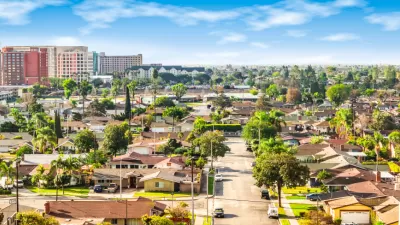A development battle pitting Contra Costa County against the East Bay Municipal Utility District illustrates the challenges of developing new housing supply in a time of drought.

According to unnamed experts cited in a paywalled article for the Mercury News by Ethan Varian, it’s possible to balance conflicting housing and water shortages in California—despite the numerous ongoing legal conflicts in the state that seem to suggest it’s one or the other.
“When Contra Costa County supervisors last summer signed off on 125 new homes slated for 30 acres of grazing land in the oak-dotted Tassajara Valley, they were warned water was going to be an issue,” reports Varian. “Supervisors pushed ahead anyway, and the [the East Bay Municipal Utility District] promptly sued to halt development plans.”
The development, called Tassajara Parks, is only one example of the challenges facing the Bay Area as it faces two crises: the persistent drought conditions, expected only to worsen as a result of climate change, and some of the most expensive, inaccessible housing prices in the entire country.
“But experts and municipal planners say the region can still balance its water and housing needs well into the future – as long as it continues to bolster conservation efforts for homes and businesses while promoting denser development and finding sustainable ways to increase water supply,” writes Varian.
The region is facing intense pressure to deliver more housing from the state. The state is requiring the Bay Area to approve over 441,000 new units between 2023 and 2031, according to the article, more than double the region’s current eight-year housing goal, as set during the Regional Housing Needs Assessment (RHNA) process. The Association of Bay Area Governments has called on cities to develop multi-family housing, which uses half as much water per household as single-family housing, as one way to address the state’s water shortages.
Many parts of California, including the EBMUD service area, have already made huge strides in water conservation. “In EBMUD’s service area, for instance, the population has increased 34% since 1970 to 1.4 million people, but urban water use has dropped 42%, according to the district.”
The article cites other examples of development plans obstructed by water supply concerns, including in Marin County, to the north, and on the Monterey Peninsula, to the southwest. As noted by Varian, 80 percent of water usage in the state is devoted to agriculture.
The conflict between water and development in the U.S. West is a long-term, ongoing concern. Previous Planetizen coverage, with other states included, can be found below.
- Utah Valleys Square Off in an Old-Fashioned Water War (April 2022)
- Booming Arizona Must Confront its Water Problem (March 2022)
- Can Water Supply Keep Up with the Need to Build More Housing? (March 2018)
- Should City Planners Worry About Water Supply? (July 2015)
FULL STORY: Does the Bay Area have enough water to build housing during the California drought?

Alabama: Trump Terminates Settlements for Black Communities Harmed By Raw Sewage
Trump deemed the landmark civil rights agreement “illegal DEI and environmental justice policy.”

Planetizen Federal Action Tracker
A weekly monitor of how Trump’s orders and actions are impacting planners and planning in America.

The 120 Year Old Tiny Home Villages That Sheltered San Francisco’s Earthquake Refugees
More than a century ago, San Francisco mobilized to house thousands of residents displaced by the 1906 earthquake. Could their strategy offer a model for the present?

LA’s Tree Emergency Goes Beyond Vandalism
After a vandal destroyed dozens of downtown LA trees, Mayor Karen Bass vowed to replace them. Days later, she slashed the city’s tree budget.

Sacramento Leads Nation With Bus-Mounted Bike Lane Enforcement Cameras
The city is the first to use its bus-mounted traffic enforcement system to cite drivers who park or drive in bike lanes.

Seattle Voters Approve Social Housing Referendum
Voters approved a corporate tax to fund the city’s housing authority despite an opposition campaign funded by Amazon and Microsoft.
Urban Design for Planners 1: Software Tools
This six-course series explores essential urban design concepts using open source software and equips planners with the tools they need to participate fully in the urban design process.
Planning for Universal Design
Learn the tools for implementing Universal Design in planning regulations.
Ada County Highway District
Clanton & Associates, Inc.
Jessamine County Fiscal Court
Institute for Housing and Urban Development Studies (IHS)
City of Grandview
Harvard GSD Executive Education
Toledo-Lucas County Plan Commissions
Salt Lake City
NYU Wagner Graduate School of Public Service





























